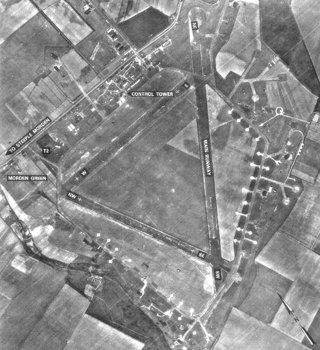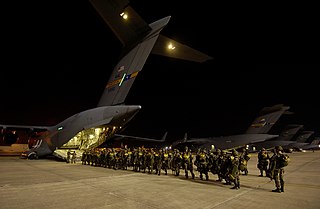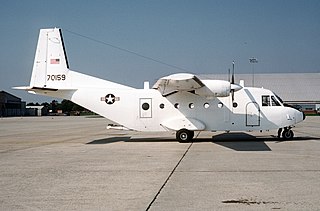
The Hump was the name given by Allied pilots in the Second World War to the eastern end of the Himalayan Mountains over which they flew military transport aircraft from India to China to resupply the Chinese war effort of Chiang Kai-shek and the units of the United States Army Air Forces (USAAF) based in China. Creating an airlift presented the USAAF a considerable challenge in 1942: it had no units trained or equipped for moving cargo, and there were no airfields in the China Burma India Theater (CBI) for basing the large number of transport aircraft that would be needed. Flying over the Himalayas was extremely dangerous and made more difficult by a lack of reliable charts, an absence of radio navigation aids, and a dearth of information about the weather.

Royal Air Force Steeple Morden or more simply RAF Steeple Morden is a former Royal Air Force station located 3.5 miles (5.6 km) west of Royston, Hertfordshire, England.
The 4th Combat Cargo Group was a World War II United States Army Air Forces combat organization that served in Tenth Air Force as part of the China Burma India Theater of World War II.

The 317th Airlift Squadron is part of the 315th Airlift Wing at Charleston Air Force Base, South Carolina. It operates C-17 Globemaster III aircraft supporting the United States Air Force global reach mission worldwide. It continues the histories of three squadrons with airlift missions that bear the number 317.

The 16th Special Operations Squadron is part of the 27th Special Operations Wing at Cannon Air Force Base, New Mexico. It operates the AC-130W Stinger II aircraft in support of special operations.

The 108th Operations Group is a unit of the 108th Wing of the New Jersey Air National Guard, one of the many units stationed at the McGuire AFB entity of Joint Base McGuire-Dix-Lakehurst, New Jersey. If activated to federal service with the U.S. Air Force, the group is gained by Air Mobility Command.
The 443d Operations Group is an inactive United States Air Force unit. Its last assignment was with the 443d Airlift Wing, being inactivated at Altus Air Force Base, Oklahoma on 1 October 1992.

The 427th Special Operations Squadron is a specialized, covert unit of the United States Air Force. After reporter Andreas Parsch filed a Freedom of Information Act request, the Air Force told him the unit "support[s] training requirements ... for infiltration and exfiltration." That is, it prepares troops for secretly slipping into and out of dangerous territory. The squadron is not listed by the Air Force Historical Research Agency. It is reported by the press to be stationed at Pope Field, North Carolina.

Alachua Army Airfield, was a World War II United States Army Air Force airfield, located 4.2 miles (6.8 km) northeast of Gainesville, Florida.

Dinjan Airfield, also known as Dinjan Air Force Station, is an air base of Indian Air Force. Established as an air field in World War II, it is located in Dinjan, approximately seven miles northeast of Chabua, in the state of Assam, India.

Chakulia Airport is an airport in India. It is located southwest of Chakulia, a town and a notified area in Purbi Singhbhum district in the state of Jharkhand.

Dudhkundi Airfield is an abandoned airfield in India, located 12 miles (19.2 km) SE of Jhargram, in the Jhargram district in the Indian state of West Bengal.
Guanghan Airport is an airport southeast of Guanghan, Sichuan, China. Formerly a military airfield known as Kwanghan Airfield (A-3) during World War II. It is now used by Civil Aviation Flight University of China for pilot training and has no commercial flights.
Nampong Air Force Base is a Myanmar Air Force base in Myitkyina, Myanmar (Burma).
Tingkawk Sakan Airfield is a former wartime United States Army Air Forces airfield in Burma used during the Burma Campaign 1944-1945. It is now abandoned.
Dohazari Airfield is a former wartime United States Army Air Forces airfield near Dohazari in Bangladesh used during the Burma Campaign 1944-1945 of World War II. It is now abandoned.
Pungchacheng Airfield is a former World War II United States Army Air Forces airfield in China, located approximately 25 miles west of Quzhou in China.

The 315th Troop Carrier Squadron is an inactive United States Air Force unit. It was last active with Tenth Air Force, based at Kent County Airport, Michigan, where it was inactivated on 27 June 1949.

The 459th Flying Training Squadron is a United States Air Force squadron tasked with providing undergraduate flying training for Euro-NATO joint jet pilot candidates. Based at Sheppard Air Force Base in Texas, the unit draws its lineage from a fighter squadron that served in the China-Burma-India Theater during World War II, where it saw service against the Japanese. The squadron currently consists of instructors from seven different NATO countries.

The 330th Troop Carrier Squadron is an inactive United States Air Force unit, last active briefly as the 330th Airlift Flight, a personnel airlift unit, in 1993. The squadron was first activated in 1944 as the 9th Combat Cargo Squadron. The squadron was activated in India and served in combat in India and Burma. In October 1945, the squadron was redesignated the 330th Troop Carrier Squadron and moved to Shanghai, China, where it inactivated in April 1946.















